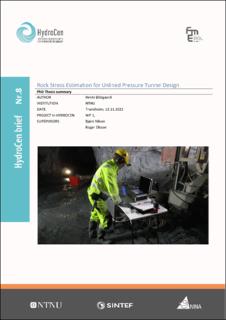| dc.description.abstract | In underground hydropower projects rock tunnels are used extensively to convey water for the purpose of generating power. As these tunnels represent a major cost element in typical hydropower developments, efforts are made to ensure that the tunnel design is cost-efficient. Under Norwegian tradition the principal cost reducing measure is to keep most of the tunnel length unlined and steel line only a relatively short section of the tunnel.
This approach requires that the rock stress in the unlined tunnel sections exceeds the internal water pressure, to avoid hydraulic failure of the tunnel. Information on the underground state of stress thus is crucial. The current approach to gain information about the underground state of stress is to perform in-situ rock stress estimates. To save costs, such measurements are typically performed at relatively few test locations, leading designers to use interpolative techniques to assess stresses between and beyond test locations. As the distance between test locations increases, so does the risk of leaving tunnel sections with insufficient stress undetected (Ødegaard and Nilsen 2018).
In this thesis, a new methodology for rock stress estimation is suggested to mitigate this undesirable situation, involving a reduction of the distance between test locations by performing measurements more regularly along the entire length of unlined pressure tunnel. For this approach to be financially and practically feasible, measurements must be made more rapid and more efficiently than they are done with the currently available test methods. A new hydraulic jacking test protocol, the rapid step-rate test (RSRT), is proposed as an alternative to the available methods (Ødegaard and Nilsen 2021).
The RSRT test protocol has been developed through a series of experiments using a custom-built true-triaxial test rig, where laboratory controlled hydraulic jacking tests were conducted. The experimental results suggested that the RSRT enabled reliable estimates on fracture normal stresses, and the RSRT protocol was therefore tested in full-scale field conditions at the Løkjelsvatn HPP. The field experiments confirmed the laboratory findings that fracture closure could be detected through analysis of the fracture closure stages of the RSRT, and further that the normal stress estimates were representative for the in-situ state of stress (Ødegaard and Nilsen 2022).
Through field- as well as laboratory testing the RSRT protocol has demonstrated a promising ability in estimating fracture normal stress, and it is therefore believed that the new test protocol may serve as a rapid alternative to current rock stress estimation methods that is well suited for adoption in the proposed new rock stress testing methodology. | en_US |
